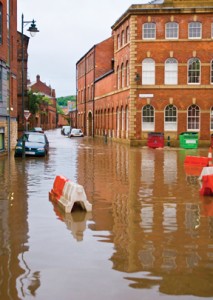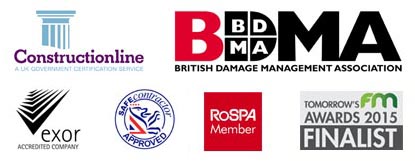March 2013 – Don’t save it for a rainy day – As featured in Tomorrow’s Cleaning March 2013
Alan Lewin, Business Development Director of ServiceMaster Clean, explains how businesses can protect their property from unexpected damage.
Whether it’s heavy rain, flooding, snow, or storms, the weather is one of the most popular topics of conversation in the UK. It may be a good ice-breaker at a client meeting or dinner party, but it can also cause unexpected and extensive damage to property and affect business operations.
External elements such as sudden flash floods aren’t the only water risk to property. Water escaping from burst pipes or leaking taps is the most common commercial property damage, ac counting for 36% of claims according to analysis of ServiceMaster Clean’s damage management work undertaken last year.
ServiceMaster Clean provides an emergency restoration service, Restoration Response”‘, to put property back to pre-damage condition, offering peace of mind to businesses of all sizes across the UK. This is free to sign up to, in advance, to deliver one of the fastest on-site response times to an unexpected emergency, with the single goal of getting you back to business fast. All aspects of disaster restoration services are covered, including water damage, flood, fire and smoke damage, building drying and dehumidification and malicious damage restoration- such as graffiti removal and needle sweeps.
Act fast
With water damage of any kind, fast action should be taken to dry your building as quickly as possible, as water will penetrate rapidly and the humidity needs to be controlled to prevent secondary damage. The four key stages to water damage restoration
– assessment of the damage, water removal, drying out, clean up and restoration- should always be undertaken by professionally qualified experts.
International Dance Supplies is the UK’s largest wholesale dancewear supplier, providing dance teachers and dance shops with quality dancewear worldwide. In 2012, its headquarters, based in Devon, were seriously damaged by water escaping from a mains water pipe connected to a hot water dispenser. The water spread, saturating carpets and floors in the first floor open plan office area and travelling through the ceiling to the ground floor, bringing the ceiling tiles down with it.
If a structure is not dried out correctly, its moisture can become a sour ce for dry rot, bacteria and growth of toxic mould, which itself becomes a health hazard. In the case of a fire, the damage can continue from smoke and toxic fumes long after it is put out.
Fortunately, the company had the foresight to pre-register with ServiceMaster Clean’s Restoration Response service, as it is based in a part of the country known for
heavy rain and floods. The company used the emergency helpline to call in their local branch of ServiceMaster Clean which has a team of professionally qualified contractors trained in specialist restoration techniques to British Damage Management Association standards.
This type of damage can have a large financial impact, with the Association of British Insurers reporting that escape of water claims cost £730 million in 2010, with the average claim cost for damage being around £2,000.
ServiceMaster Clean understand that the main priority for businesses is to continue their operations with minimal disruption. The key benefits of using a specialist service, like Restoration Response”‘, are that there are no delays waiting for your insurers to appoint a supplier, whilst ensuring the restoration works are compatible with loss adjuster and insurer processes.
Depending upon the nature of the damage, ServiceMaster Clean uses a range of equipment tailored to the restoration process. This can include lighting towers if there has been a serious fire, as buildings may be covered in smoke and ceilings and walls blackened, which soaks up the light. Access equipment such as scissor lifts, cherry pickers or scaffolding may also be required as well as extraction equipment and dehumidifiers. In this case, specialist drying equipment was used as an initial containment measure, followed by the installation of a more advanced drying system involving tenting the affected areas for concentrated drying.
Prior to installing the advanced system at International Dance Supplies, all the affected carpets were uplifted for restoration, exposing the concrete beneath. A thick layer of adhesive was discovered on top of the concrete, which was removed so that it did not hinder the drying time, allowing the moisture to be released from the concrete.
For health and safety reasons, temporary traffic lanes were se t up throughout the offices with warning signs so that the premises could remain open and business could continue as usual. Temporary entrance matting was laid until the restoration could be completed.
Allison Glanville, Business Administration Manager at International Dance Supplies said: “After major water damage at our premises, ServiceMaster Clean was outstanding in the delivery of its Restoration Response service and in dealing with the situation. They were very mindful of our business needs, caring and very professional throughout the whole drying out process. I would not hesitate to call them again, should the need arise and I would certainly recommend them to others.”
Be prepared
If your business is damaged this can be costly in terms of time and money. You should have a list of important contacts. including your insurance company and disaster restoration specialists, which can help you quickly return back to ‘business as usual’ in the event of property damage.
ServiceMaster Clean’s specialist service, Restoration Response guarantees fast response to a wide range of commercial organisations within a few hours of an emergency, to star t putting the proper ty back to pre-damage condition.
Remember that by taking precautions, many cases of damage to buildings can be avoided. For instance:
• Monitor weather conditions and take appropriate precautions to protect the building.
• Invest in security to help protect the property.
• Look for signs of water penetration in the roofing, exterior walls and foundations.
• Insulate pipes to help prevent unexpected burst pipes due to frost damage and ensure that the central heating is not left off for any length of time during winter.
• Always turn taps off after use and deal quickly with leaking taps.





